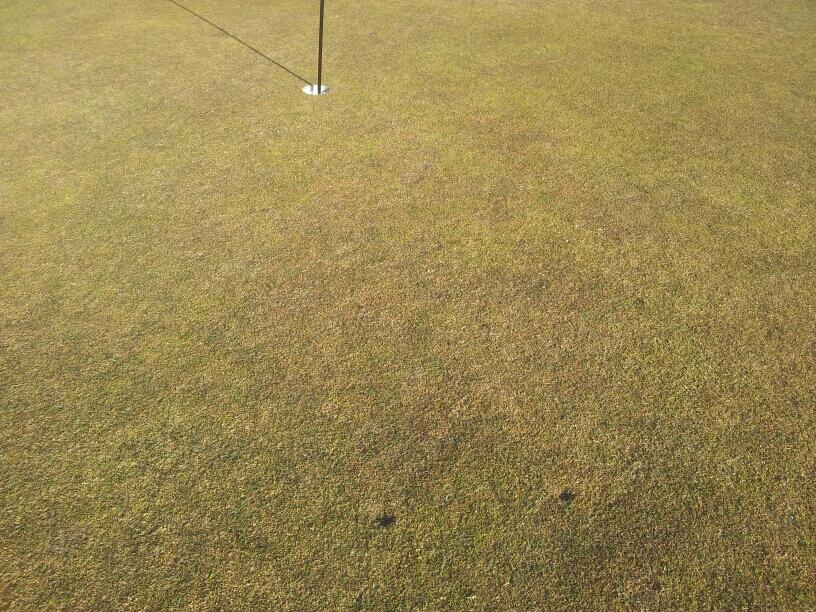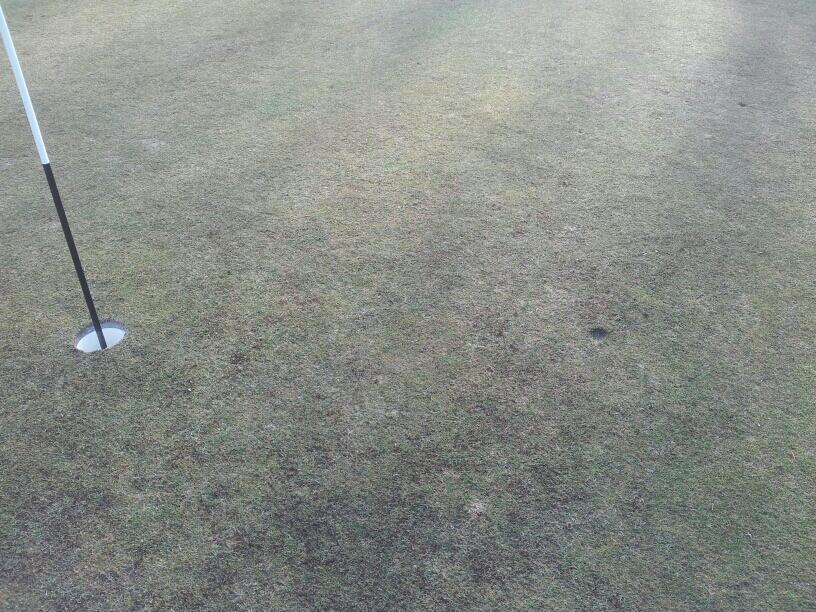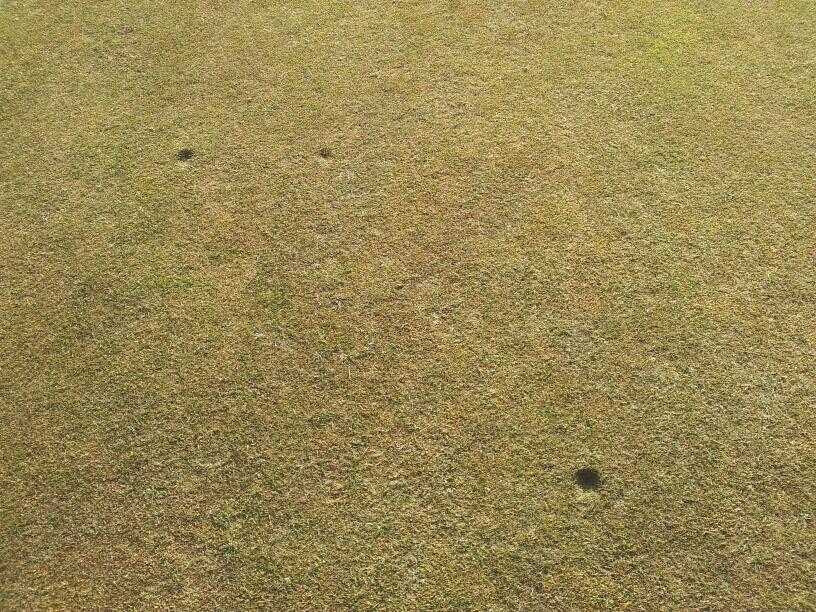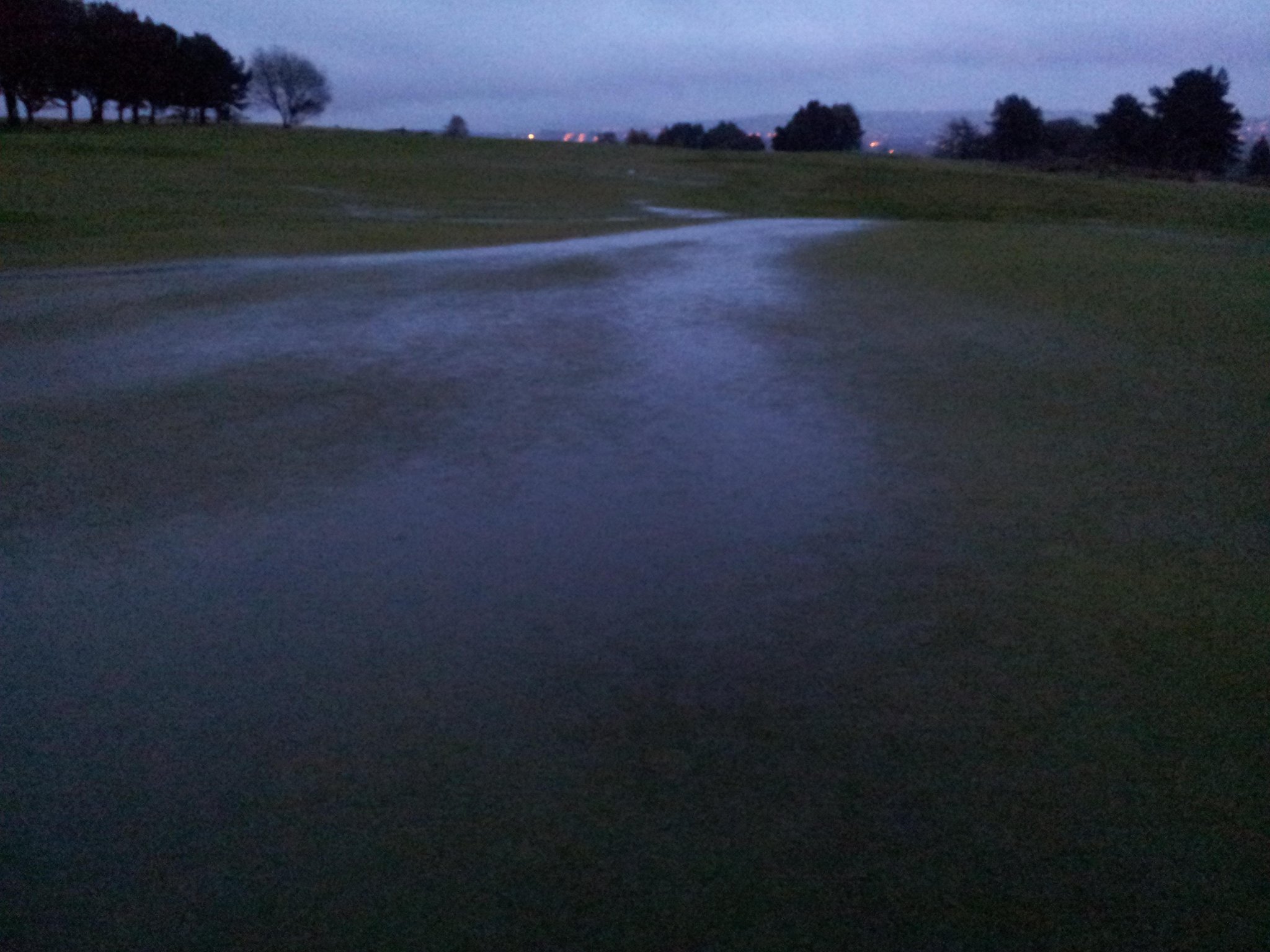Birdboxes
Friday, 20 December 2013
Wednesday, 18 December 2013
Ninth Winter Tee
Ninth Winter Tee
A winter tee has been reconstructed on the ninth hole. This was done many years ago but over the years it has been left to grow. Therefore we strimmed the area down, removed any thick clumps of rush grass, added more fresh sandy soil and returfed the area.
 |
| Tee after strimming |
 |
| After soil and turf |
The area is still needing more time for the turf to properly knit together but as soon as it is fit, we can use it. A major benefit to using this tee in the winter is that it takes a lot of wear and tear away from behind the 8th green, which is prone to waterlogging.
Ninth Green
Ninth Green
The ninth green has become very wet this autumn and it appears that it is struggling to dry out. We have had a few exploratory digs around the area to find out if there was a fundamental problem but it appears that, just like some of the greens down the bottom of the course, it is a very thatchy green that will only really improve with the installation of some drainage.
This problem was discussed at a recent directors meeting and the decision was made to install some drains through the worst sections of the green. Therefore this week we have started this work as the green would be out of play anyway due to its present condition.
 |
| Drains - Turf Cut |
This work will continue at present, albeit at a slow pace due to weather conditions, staff holidays, Christmas week etc but it will be completed as soon as possible. I will keep you updated of its progress.
Trench Cut Front Left To Catch Water Running On
As the green is too soft for major machinery we are using a pedestrian trencher on boards to cut the drains. The debris is being removed by hand.
At the same time we have removed some turf at the back left of the green. In this area some soil has been taken away to create a small swail to take water away from that area.
Swail created to take water away from back left
The green has now been completed and a germination sheet has been placed over the cut turf to hopefully aid it in its recovery during the oncoming cold weather.
Aquadyne placed in trenches
Turf put back on trench lines. Edges Forked.
Boards used to reduce wear
Drain runs into an existing pipe drain.
Germination sheet pegged onto laid turf.
The Aquadyne was placed in the trenches and then rootzone was added to top up the trench, before the turf was replaced. The rootzone was made up of a sand soil mix to try and avoid the chance of the trenches drying out in the summer. The green is very thatchy and extra work this year will be required to help to firm up the surface, as it is very soft and holding water. The drains will help but they are not an entire solution. More hollow coring, sanding and spiking will be required to provide better surfaces.
Woodland Management
Woodland Management
During times when we have had frosts we have been busy working on our woodland management plans. There are many different types of tree and bush in our habitats and they are being identified, inspected and plans are being made for the best way to manage the sites so they flourish for years to come.
Hollow Coring
Hollow Coring
Once the season had finished we embarked on the process of hollow coring our greens. The reason for doing this is for soil exchange. We take out the thatchy material which holds moisture and replace it with a more free draining sandy topdressing.
 |
| Dried sand added to green
|
 |
| Holes Filled |
In order to achieve the best results we have had the sand dried before delivery in order to remove all moisture. This way when applied to the green the sand simply falls down the holes making hundreds of little drainage holes all over the green.
It is important to remember that although we hollow core all over the green, we are actually only taking out around 5% of the thatch in one go.
Obviously carrying out this operation earlier in the season, ie August/ September time would mean that recovery would be much faster. However it is better to do it than not at all. The greens are thatchy and continuous works are in order to make them the best they can be. Aeration work such as solid spiking and slitting will continue throughout the winter.
March 14: The remaining greens have now been cored and sand filled. Recovery of these greens will be far quicker due to the increase in temperatures. Also we had a demonstration of a brilliant piece of kit called the Sweep and Fill brush. This set of rotating brushes flicks the sand into the holes and moves the sand where it needs to go.
This machine can also be used to groom the grass, i.e. stand up the grass blades to provide a better cut. This would allow for smoother and faster surfaces. It can be used after topdressing or on its own as a stand alone brush. It also can be used to stripe rough grasses for improved presentation.
Thursday, 17 October 2013
Scarifying Greens
Scarifying Greens
 |
| Scarification lines |
We have used a contractor to scarify the greens. The first was left alone due to the turf issue and the eighteenth wasn't able to be done due to the late afternoon heavy rain. However all the other greens were scarified, verticut and the remaining debris blown away. This is a necessary maintenance task in the fight to remove the thatch which is constantly building up. If we replace this sponge like material with a more free draining sandy topdressing the greens will eventually become firmer and therefore faster, and not so prone to waterlogging.
 |
| Close up of the thatchy material removed |
Each green had approximately one ton of thatch removed via a conveyor belt and out onto the back of our gator utility vehicle.
Amount taken from a green
After the green was blown free of any debris, the hole was reinstated. The greens will now be topdressed and overseeded with bent grass so that we can introduce finer species. This procedure takes out double the amount of thatch than hollow coring, however coring will still take place as soon as conditions allow so that we can replace even more.
Ready for topdressing
Thatch Removal
The greens were then topdressed. We use a sandy soil mix with added composted material.
Topdressing
Dragmat topdressing
Sand in lines
Greens rolled
Sunday, 6 October 2013
Vandalism
VANDALISM
Unfortunately last Monday evening we had a bout of vandalism where a motorbike was driven over four of the greens. The 3rd, 13th, 14th and 5th greens were affected. Luckily in a way only one of the greens was badly damaged with the other three only needing soil and seed and some forking to repair it.
 |
| 5TH GREEN |
The 5th green however was more widely damaged and has needed the damaged turf to be lifted and replaced. I decided to replace it with turf from the green surround at the back as this turf is the same species and should knit in much better than new bought turf.
 |
| TYRE DAMAGE CLOSE UP |
The turf which has been relaid has been topdressed and washed in. We will try and keep it as level as possible with regular dressings. Hopefully it will settle in as soon as possible.
14th Drainage
14th Hole
We have finally been able to install drainage to the par 3 14th hole. We have used a contractor to dig trenches at 5m spacings and then pipe and stone was installed to go into the ditch which runs the length of the hole.
 |
| Pipe installation |
 |
| An example of some of the boulders we pulled out. |
 |
| 14th Greenside trench. |
Once the pipe was installed and the gravel laid on top, we filled the trench with a sandy soil mix. A final soil and seed mix will be added to finish off the lines. The area near the green will be levelled and returfed.
The lines will remain GUR until further notice. More pictures to follow.
Sunday, 15 September 2013
Himalayan Balsam
This link is a report carried out by Deputy Head Tony Wainwright with regard to the Himalayan Balsam issue at the club.
https://www.dropbox.com/s/vi0pfvw5d4l1g8g/Himalayan%20Balsam%202013.docx
https://www.dropbox.com/s/vi0pfvw5d4l1g8g/Himalayan%20Balsam%202013.docx
Wednesday, 4 September 2013
Work on fairways
We have started some renovation work on the fairways by scarifying and collecting the debris. Half of the fairways have been completed so far. Over the autumn period the fairways will also be vertidrained to the maximum possible depth and the slitter will also be used to help aerate and make improvements to their drainage capability.
 |
| Scarifying reels used on fairways |
The scarifying machine is a three unit tractor mounted one which is fully adjustable to reach the required depth. As our fairways are very thatchy it was necessary to not go too deep as there is hardly any root depth. Further aeration will help to increase this.
 |
| Contractor collecting debris
|
 |
| Ten tons of thatch debris taken off fairways 3 and 6 |
Much more work is required to bring the fairways back to a satisfactory condition but with increased aeration through spiking and slitting they will continue to improve.
Work on tees
There has been quite a lot of work carried out on the tees in the last month to improve their playability. After the arrival of the Procore aerator the tees were all spiked using 1/2 in tines.
 |
| Procore spiking on the 12th tee |
After the tees were spiked the worst bare areas were then heavily topdressed and overseeded with fescue.
 |
| Seed and Topdressing Levelled out |
 |
| 7th tee |
Fertiliser was added to encourage growth and colour and with some favourable weather the tees now are looking a lot healthier. Aeration is the key to the tees' success and with the imminent purchase of a Vertidrain deep aerator they will improve further still.

Friday, 26 July 2013
Greens Update- Irrigation
Irrigation
The greens are still growing well during this hot spell but unfortunately the irrigation system has let us down on a number of occasions. The way the system is configured means that the course is split into several sections. There has been an electrical wiring fault on the system in the section which controls the greens at the bottom of the course, i.e 3,4,5,13,14 and 15.
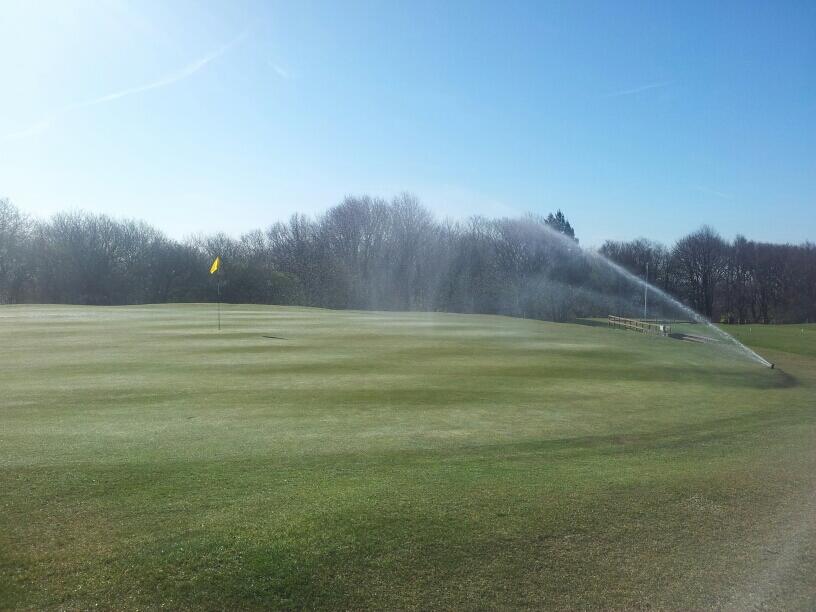 |
| 18th Green Irrigation working well. |
Due to this problem these greens have not received the amount of nightly water required to keep them in prime condition. Typically four of these greens have had drainage work done in the past and the drain lines are clearly visible. This is due to the lines having sand underneath them rather than the original soil like the rest of the green.
As I type the system is not yet fixed but we have narrowed down the problem and we hope to have it sorted out as soon as possible. The seventh green has also been affected due to vandals prising open the secured irrigation box and ripping out the decoder. Until it is fixed those affected greens are being manually watered first thing every morning. Some of the original sprinklers on those greens have been replaced as they were very inefficient. Two sprinklers on the first green have also been replaced.
Talking of the first green, the turf which was ordered a while ago is now available and should be delivered on Monday. The golf calendar is very busy over the next two weeks but we will do our best to put the turf down as quickly as possible. All the drain lines on the greens affected will be topdressed and we have bent seed available to put in small areas to encourage new growth.
On a brighter note the dry conditions have worked very favourably for the bent grass in the greens. It has really come on this year and can be clearly visible in patches on the greens. This is the favoured type of grass that we would want in our greens and with balanced nutrition at an optimum the bents have chance to succeed.
As I type the system is not yet fixed but we have narrowed down the problem and we hope to have it sorted out as soon as possible. The seventh green has also been affected due to vandals prising open the secured irrigation box and ripping out the decoder. Until it is fixed those affected greens are being manually watered first thing every morning. Some of the original sprinklers on those greens have been replaced as they were very inefficient. Two sprinklers on the first green have also been replaced.
Talking of the first green, the turf which was ordered a while ago is now available and should be delivered on Monday. The golf calendar is very busy over the next two weeks but we will do our best to put the turf down as quickly as possible. All the drain lines on the greens affected will be topdressed and we have bent seed available to put in small areas to encourage new growth.
On a brighter note the dry conditions have worked very favourably for the bent grass in the greens. It has really come on this year and can be clearly visible in patches on the greens. This is the favoured type of grass that we would want in our greens and with balanced nutrition at an optimum the bents have chance to succeed.
Sunday, 30 June 2013
Greens Update and Staff News
The greens are coming on all the time although it has taken a much longer time than usual. It has been very frustrating but we are starting to see signs of the work put in earlier on.
After the cold spring and all the aeration work we did we were waiting for higher soil temperatures to kick start significant growth. We had fertilised but the ground was just too cold but now it has reached a temperature enabling it to create good growing conditions. We have fertilised again using the same 10 0 10 organic granular feed we used last time. More was used this time to try and make sure we got the most benefit of the hotter conditions.
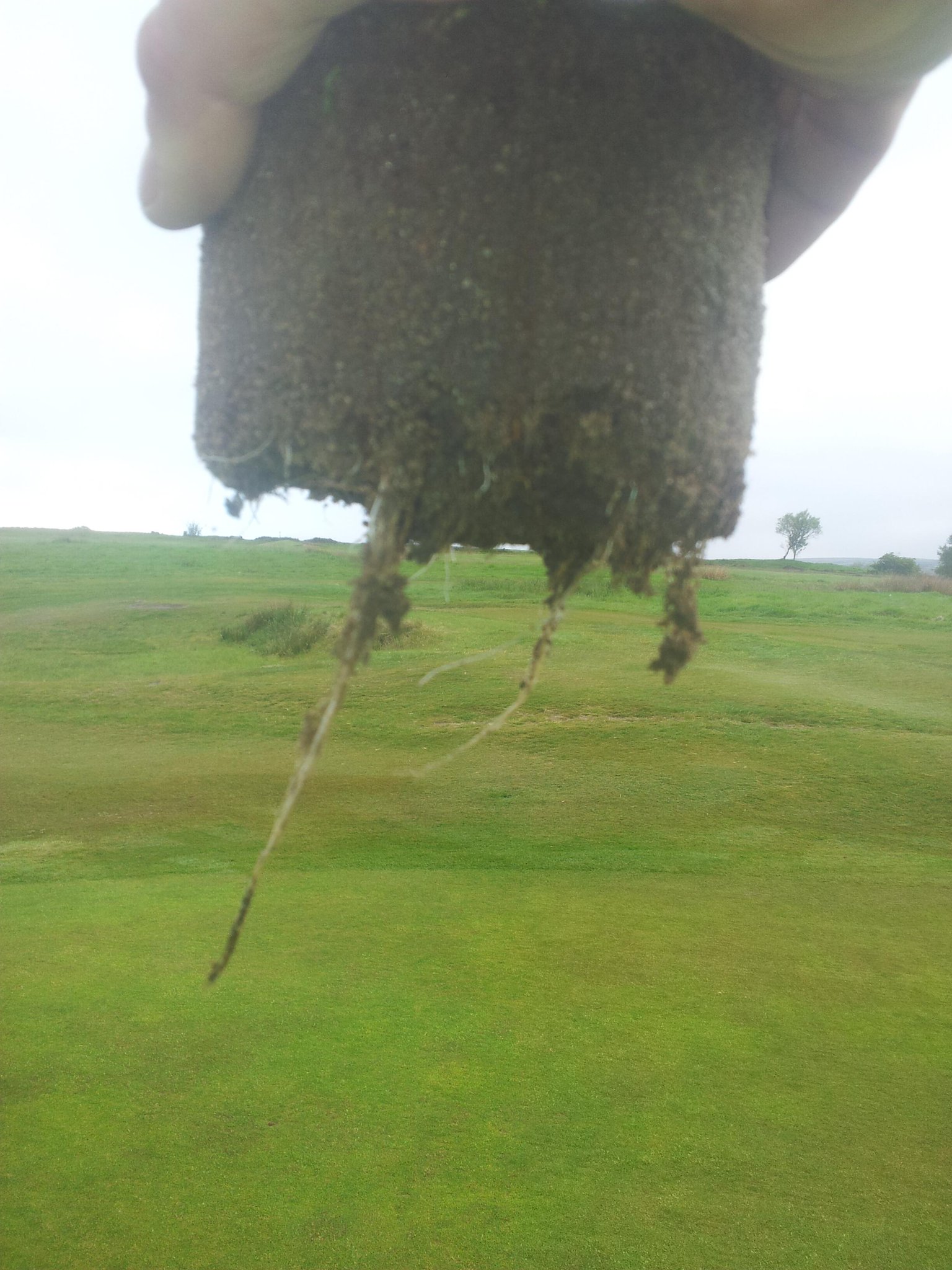 |
| Signs of roots reaching further into the profile after aeration.
|
 |
| Wear from golf around a hole one day after fertilising. |
This fertiliser has well and truly kicked in now and we have lush growth. This does mean that we are taking plenty of grass off but the greens will be slow, especially in the afternoon. Also, having topdressed a couple of times recently, the blades on the cutting units have become blunt. This means that they do not cut as they should but rather rip the grass. This means the roll of the ball is seriously affected and the grass just stands back up, again slowing the ball down. The units are going away to be sharpened and have new bottom blades fitted which will enable a much better finish with a smoother, quicker surface.
The irrigation system has been used on a regular basis to keep the moisture levels required for a decent surface. However we did have a couple of issues with the irrigation system typically during a really hot spell. The water meter in the borehole had become silted up over the years which meant the amount of water being pumped back into the tank was insufficient. Therefore when the water had run out it meant the system wouldn't work. The meter has now been replaced and the flow of water is much better. We have also replaced three sprinklers on greens where they were broken which will improve efficiency.
The drain lines on the greens were the biggest casualty in the hot spell, especially on the first green. The right hand side of the green is extremely bad and additional wetting agent and extra watering has unfortunately not been able to solve the issue there. We will returf the worst areas with greens quality turf which has been ordered. However our supplier has also had problems with growth this year for similar reasons, i.e cold wet etc, and so they have suffered with the quality of their product. They have treated the turf and as soon as it is fit we will have ou delivery. I am searching for quicker alternatives of similar quality. The rest of the drain lines will be topdressed and overseeded with bent seed where required.
The area at the back of the first green was returfed in the winter because it was in such a wet poor state. This was mainly caused by the greens mower turning at the foot of the bank and causing extra stress on the turf there. Therefore we decided to decrease the the size of the green along the back edge and cut it as a full size fringe. This allows us to turn more freely and not cause as much wear. The back left area has not been cut as green for quite some time but unfortunately we never really got sufficient growth to show true definition. It has started to come on now and you can see the back edge cut of the green quite clearly.
The amount of staff has really curtailed what we can do on both the greens and all the little jobs needed to tidy up the course. We have only had three of us working on the course more or less since the beginning of April. However we have managed to source some quality staff to join us. Pat has already joined and has made an instant improvement to work standards and ethic, gladly working overtime. He has worked at Leyland GC and has gained lots of experience working on three different golf courses in the U.S. Monday sees the arrival of Tony who will take on the role of Deputy Head, a role he has successfully carried out for the last six years at Turton GC. We welcome them both and look forward to them helping improve the golf course standard. We will shortly have more staff news.
Sunday, 19 May 2013
GREENS
GREENS
It is fairly obvious to see at this moment in time that the greens are not where we would want them to be, and believe me no one is more frustrated about it than me. This is down to several different factors including a late growing season, soil temperatures, different grass growth, lack of aeration, not to mention the weather.
Having had discussions with the club over the years it was felt necessary to try and include some necessary maintenance during the season and so in recent years we have tried to clear the diary during May to carry out these procedures. However these type of "maintenance weeks" seen at lots of clubs don't always work out the way you want them to as mother nature sometimes doesn't read the diary. Certainly having one Monday in May isn't the best option as maintenance should be carried out little and often right through the year if good surfaces are to be expected.
Due to the very cold spring and lack of any real growth at this time it was decided that hollow coring or scarifying to pull out thatch was not the best idea due to the speed of recovery. Unless conditions are well in favour then these sort of procedures are best left until the autumn.
Therefore I decided to aerate the greens using a Vertidrain on Monday morning. Below is a picture of one in action, carried out by Fine Turf Services as currently we do not have one of our own. The greens were cut before this operation and after each green had been aerated I fertilised with a granular application of a 10-0-10 urea based fertiliser which also included some other nutrients such as Iron and Magnesium to assist with giving the greens some better colour.
As you can see the Vertidrain punches holes into the ground with a pitchfork action.
As you can see the Vertidrain punches holes into the ground with a pitchfork action.
 |
| Vertidrain 18th Green
As it reaches the bottom of its run it heaves the ground and this creates holes in the soil profile (see below). These holes in turn allow air, water and roots to penetrate deeper down. The roots are able to reach further down under ground, creating stronger and healthier turf and the water that lands on the surface has much more chance of draining away.

Holes created in soil deep below
Having had around half an inch of rain fall on Tuesday night and then an inch fall on Wednesday alone closing the course in the morning, it was possible to open the course late in the afternoon, something which would have been impossible without this procedure.
On Tuesday we topdressed the greens with almost twenty tons of a sandy, composted soil blend which has been mixed together and heated before being delivered. This type of topdressing gives a small amount of its own nutrition to the greens due to the compost content. You could actually still feel the heat off the pile when it was delivered.
The topdressing was then ran over with a dragmat to smooth it into the green. However unfortunately during this operation we had some rather heavy showers of rain which were not ideal. This meant that the topdressing was rather smeared into the surface because it had got wet. I thought it best to carry on though as the forecast for Wednesday was horrible.
Wednesday morning we arrived at work to find the course under water and it was clear as the morning progressed that no work further work could be carried out on the greens that day. A whole day lost on such an important task is far from ideal and in total we had 44mm of rain in approximately 36 hours.
On Thursday the greens were dry enough for us to brush and cut them for the first time since Monday morning. It was clear to see that much of the fertiliser and some of the topdressing had been well washed in but in many areas where growth is weak the soil was still clearly visible. Obviously it helps when it is dry so that it disappears lower into the base. Many of the holes from the Vertidrain had been closed up although their benefit will still be working underneath for time to come and it will hold the greens in good stead in the long run.

On Friday the greens were again brushed and cut and this time they were ironed as well using the Tru Turf roller. Obviously the greens are not in their prime condition but it has been quite a disruptive week for them, but very beneficial. A huge amount of work has gone into them which will only be for the better. Short term disruption for long term gain.
Once the soil temperatures pick up enough to promote stronger growth we should see an improvement. The greens will drain better and the roots now have more room to grow stronger and deeper, again producing better quality in the future. This amount of disruption is not the norm but I felt it necessary especially having worked hard to create space in the diary. On a more regular basis we will sarel roll the greens and topdress very lightly to help smooth out the surfaces. Also the greens will be verticut to thin out more of the coarses looking grasses, thus providing a more uniform appearance. This will happen shortly and will be discussed on here at the time. Patience is key at this time.
|
Wednesday, 15 May 2013
No Growth
No Sign of Greens Growth
The greens are still not showing any real signs of growth, especially with the temperatures remaining colder at nights. Talking to other greenkeepers in the area and reps who visit many clubs the feedback is the same. They talk about being around a month behind schedule with regards to where they should be. We can try many different things such as use of fertiliser and other products but unless we receive some help from mother nature with regards to sunshine and an increase in soil temperatures, the greens will continue to make slow progress.

 |
| Bent and poa grasses |
The following diagrams show how the last few years have varied with regard to soil temperatures. Generally conditions require temperatures to be above 6 degrees to achieve any growth. The first diagram shows how many days were higher than 6 degrees. The second shows how many of these days there were in total. It is clear to see how fewer we have had this year compared to last, accounting for the lack of growth. (These figures were accumalated in the midlands, but a similar pattern if not worse has happened in the north west).
| Courtesy of Mark Hunt, Headland |
| Courtesy of Mark Hunt |
Usually this subject of uneven growth and bobbly greens rears its head around April time, or Augusta syndrome time, but we are only now at the middle of May and the growth still resists. The next topic will be spring maintenance, the value of aeration and the use of topdressing.
Monday, 15 April 2013
Early Spring Greens
Early Spring Greens
There has been some recent criticism about the greens. Hopefully I can explain a few points which might answer some questions.
 |
| 1st Green and the bunkers have disappeared. |
Having just experienced one of the wettest years in history, we are just about coming out of one of the coldest and longest winters. We have had several large snow falls, some of which drifted to several feet on the surfaces. During the wet season last year, it was almost impossible to carry out all the normal necessary maintenance operations, eg. topdressing, spiking etc because the greens were saturated.
Samples of pitchmarks on greens
Therefore the thatch which normally formulates over the year has not really been attacked in the same way as normal. The greens have been soft, wet and spongy for large periods of time and in turn slow and footprinted. The greens were vertidrained during the winter to allow air and water to travel deeper into the soil profile and to encourage deeper rooting. This was carried out by a contractor.
During the recent dry spell the thatch layer and top surface have dried out meaning firmer and drier greens but due to the temperatures being so low and with a much reduced amount of sunlight in the winter, there has been absolutely no growth over the winter months. However we are just about seeing signs of new growth now.
We cannot expect miracles however and there is only so much we can do to influence things. Nature has to take its course and when growth begins we will be ready to capitalise.
The amount of pitchmarks on the greens is unacceptable and whenever the subject is mentioned, lots of people say that they are doing their bit. Fantastic. So maybe some self policing is needed. Tell your playing partners to repair one on each green. Keep an eye out on other golfers. If anyone doesn't know the correct way to repair a pitchmark or divot then please ask the proshop or myself and we can show you. We do not have the man hour resources to constantly repair pitchmarks and divots on the course.
Subscribe to:
Comments (Atom)



















